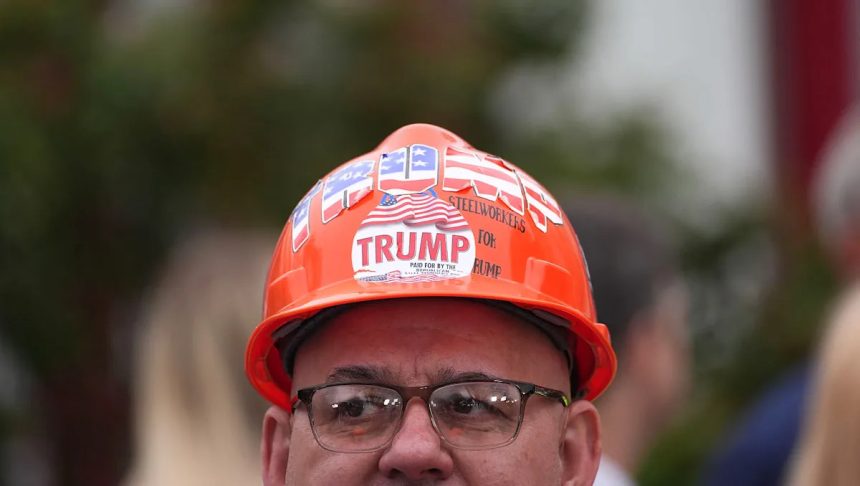The September labor market report was late, thanks to the government shutdown. And when it finally arrived on Thursday, it was also confusing. The Bureau of Labor Statistics reported that the U.S. economy added 119,000 jobs in September, well above expectations. But the unemployment rate ticked up to 4.4%, its highest since October 2021.
Of course, these monthly reports are noisy, and it’s not unusual for their indicators to point in different directions. That’s why you want to look at the trends, and one important sector, both economically and politically, has consistently trended down over the last few years. We’re talking about manufacturing, which shed another 6,000 jobs in September — the fifth month in a row of factory job losses.
You just don’t see such a pattern of job losses outside a recession, and the U.S. economy is not in a recession. The decline is a terrible fact for President Donald Trump, who made bringing factory jobs back to the U.S. central to his 2024 campaign, and is discouraging for many Americans who believed his promises.
But the decline is not surprising. Manufacturing jobs are down 194,000 (1.5%) from their most recent peak, in February 2023. That means this trend predates Trump’s second term, so his tariffs aren’t the whole problem. But the import taxes are unquestionably part of the problem. In fact, the last time that factory employment was this soft outside a recession was right after Trump implemented tariffs during his first term. After robust growth in 2017-18, between January 2019 and February 2020 American factories shed 47,000 jobs.
One reason for these losses is that half of our imports are not the “final goods” lining the shelves at Walmart and Target. Rather, they’re “intermediate goods,” or inputs into our own domestic production. It’s a simple, remarkable fact that neither the president nor anyone around him has ever addressed: When you make it more expensive for factories to produce their output, you’re going to hurt their workers. A Federal Reserve paper analyzing Trump’s first-term tariffs found that any positive impact of tariffs protecting industries from imports was more than offset by tariffs raising the prices of intermediate imports and by the retaliatory tariffs other countries levied on U.S. exports.
For more contemporaneous evidence, look no further than the monthly survey of U.S. manufacturers run by the Institute for Supply Management (ISM). For 31 of the past 34 months, survey respondents report contracting employment at their firms. But the most illuminating parts of these surveys are the respondents’ comments on how things are going for them. Here are a few of these reflections from the October report, with the first from a chemical products manufacturing firm:
Business continues to remain difficult, as customers are cancelling and reducing orders due to uncertainty in the global economic environment and regarding the ever-changing tariff landscape.
From a machine producer:
Tariffs continue to be a large impact to our business. The products we import are not readily manufactured in the U.S., so attempts to reshore have been unsuccessful. Overall, prices on all products have gone up, some significantly. We are trying to keep up with the wild fluctuations and pass along what costs we can to our customers.
And from a farm machinery producer:
The tariff trade war has negatively impacted agricultural export markets, driving down demand and price. This negatively impacts farmer revenue and the likelihood of farmers investing in new equipment.
What about the longer-term negative trend, the one that started in early 2023? Here, we turn to our previous work on the long history of U.S. manufacturing employment. Examining manufacturing data from 1949 to 2025, we found that declines in U.S. manufacturing employment occurred in periods when manufacturers increased their production efficiency — periods of high productivity growth — and demand for domestically manufactured goods was low. The “China shock” period of 2000-10 is Exhibit A of this dynamic: Technological advances made manufacturers more productive, while a flood of cheap goods from China replaced domestically manufactured goods in U.S. consumption, a combination that wiped out 5 million factory jobs.
While productivity data takes time to clearly materialize, a similar dynamic may be underway. Recent manufacturing productivity growth is robust, and if artificial intelligence adoption takes hold in the sector — it’s there now, but not very broadly utilized —efficiency gains will accelerate. To assess consumer demand for U.S. factory output, we can look to the ISM’s new order index, which measures the level of new orders placed with American manufacturers. Measures above 50% represent expansion and below 50%, contraction. Since manufacturing employment began its current slump in March 2023, the index has averaged 48%. In the two years prior, it averaged 57%.
If tariffs do more harm than good, as is demonstrably the case, what policies could help reverse the current slump? In fact, there are many key sectors in which domestic production is important to our future. This is especially true in sectors where the market may underinvest (such as clean energy, battery storage and electricity transmission infrastructure) and sectors where our national security is vulnerable to export controls from other countries (such as chip production and critical minerals refinement).
Such industrial policy requires the U.S. government to craft incentives and government investments. That requires a level of care that, to put it politely, we do not associate with the current administration, which is busy defending its (almost certainly illegal) tariff regime in the courts, bailing out Argentina to help a Trump ally and cutting deals with whoever happens to please the president in Oval Office meetings. In other words, absent true, fact-based leadership on this issue, we fear the current slump in factory employment will persist.
This article was originally published on MSNBC.com









